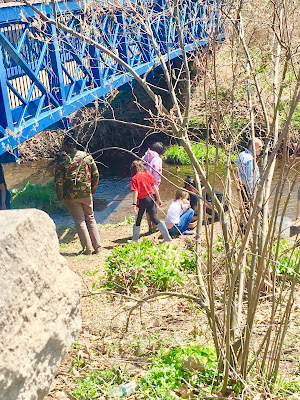Aissatou Seck
I volunteered in a movement created by South Orange Middle School science teacher named Anthony Cicenia. He and his 7thgrade class were cleaning the Rahway River. Mr. Cicenia is a great educator. He is a team leader at the school and he is well known for having amazing programs and activities that not only the students enjoy, but also learn from. He informed me about the wonderful idea of cleaning the river after we had a very fascinating conversation regarding animal extinction. Therefore, on Tuesday, April 26, I chaperoned and helped 15 children along with a few co-teachers to clean the Rahway River. It was located in South Orange and I learned a lot about that river.
I chose this project because the river has a lot of history behind it. The Arthur Kill is an abandoned river channel made by an old phase of the Hudson River. Rahway River is a tributary of the Arthur Kill in Essex, Middlesex and Union counties, New Jersey in the United States. The river also is home to many wildlife species. Birds, rats, aquatic worms, snails, maggots fish, turtles and many more live in that waterway. To add on to that, it is a home of macroinvertebrates, which are invertebrates that can be captured by a 500-meter net. Humans pollution is so severe that only a few of that wildlife can tolerate it. The most sensitive animals to that pollution are stonefly, mayfly, riffle beetle and caddis fly. If these animals get extinct, the food chain will be damaged and the ecosystem will be endangered.
I chose this project because the river has a lot of history behind it. The Arthur Kill is an abandoned river channel made by an old phase of the Hudson River. Rahway River is a tributary of the Arthur Kill in Essex, Middlesex and Union counties, New Jersey in the United States. The river also is home to many wildlife species. Birds, rats, aquatic worms, snails, maggots fish, turtles and many more live in that waterway. To add on to that, it is a home of macroinvertebrates, which are invertebrates that can be captured by a 500-meter net. Humans pollution is so severe that only a few of that wildlife can tolerate it. The most sensitive animals to that pollution are stonefly, mayfly, riffle beetle and caddis fly. If these animals get extinct, the food chain will be damaged and the ecosystem will be endangered.
The purpose of this event was to get rid of as much waste as possible from the river, including cans, plastic bottles, and plastic bags. During the event, we were all required to wear rain boots because we had to get into the river at some point to be able to get the wastes that were in the middle. We were given long handle nets, plastic spoons, ice trays, and buckets. The nets were given to us in order to be able to scoop the waste. The plastic spoons gave us the ability to put the warms back in the water in case we scooped a worm while getting rid of the waste. The ice tray was like a storage for macroinvertebrates and worms if anyone wanted to take a look at them before putting them back in the river. Lastly, the buckets were storages for the trash we might find in the river. All these materials were all provided by the school. I found a few things such as chip bags, water bottles, and candy wraps. I’ve also seen a fish, a few warms, and a few insects.
After finding all those plastic wraps, I came to the conclusion that most of this pollution is man-made. People who litter not only harm the environment, they also make the neighborhood look dirty. Peoples cars also release oil and when it rains, the oil gets into the river and makes it a harsh environment for the life that the river contains. The wind does the same with the things littered. I also learn that there is light and noise pollution also. Light pollution is known to be a high volume of artificial light. Noise pollution comes from traffic and man-made structures. Humans need to do better by putting trash in trash cans, recycling and reducing pollution to its minimum.








Comments
Post a Comment